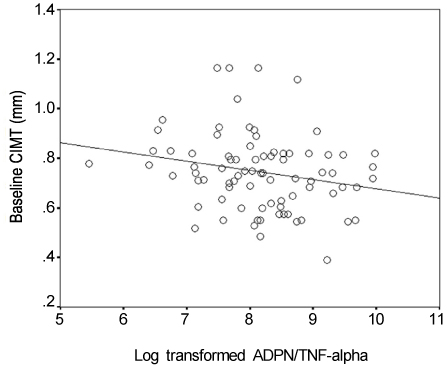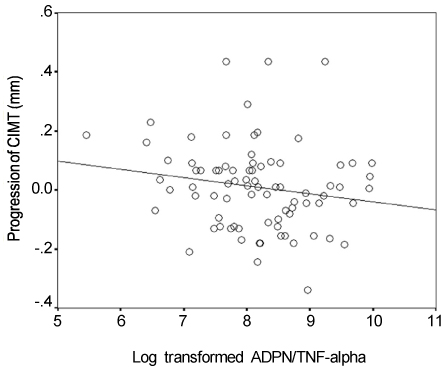J Lipid Atheroscler.
2015 Jun;4(1):7-15. 10.12997/jla.2015.4.1.7.
Effects of the Serum Adiponectin to Tumor Necrosis Factor-alpha (TNF-alpha) Ratio on Carotid Intima-Media Thickness in Newly Diagnosed Type 2 Diabetic Patients
- Affiliations
-
- 1Division of Endocrinology, Department of Internal Medicine, College of Medicine, Hallym University, Korea. ironeat@gmail.com
- KMID: 2005730
- DOI: http://doi.org/10.12997/jla.2015.4.1.7
Abstract
OBJECTIVES
Type 2 diabetes, a leading cause of cardiovascular disease, is well known for its association with accelerated atherosclerosis. Adiponectin and tumor necrosis factor - alpha (TNF-alpha), which are produced and secreted in adipose tissue, have been suggested as predictors for cardiovascular disease. However, little is known about the influence of adiponectin and TNF-alpha ratio on the progression of carotid atherosclerosis in newly diagnosed type 2 diabetic patients. This study was conducted to evaluate the influence of serum adiponectin/TNF-alpha levels on the progression of carotid atherosclerosis.
METHODS
One hundred eleven newly diagnosed type 2 diabetes patients were enrolled. Anthropometric and biochemical data including serum adiponectin, TNF-alpha were measured for each participant. Also we measured carotid intima-media thickness (CIMT) at baseline and at 1 year follow-up (n=81). We finally examined the relationship among serum adiponectin over TNF-alpha levels (ADPN/TNF-alpha), baseline CIMT, and progression of CIMT at 1 year.
RESULTS
ADPN/TNF-alpha negatively correlated with baseline CIMT (r=-0.231, p=0.025). Moreover, progression of CIMT was significant at 1 year (0.011+/-0.138 mm). There was a negative correlation between ADPN/TNF-alpha and progression of CIMT at 1 year (r=-0.172, p=0.038). In multiple regression analysis, age and HbA1c were found to be independent risk factors for baseline CIMT. However, only HbA1c was an independent risk factor for the progression of CIMT.
CONCLUSION
ADPN/TNF-alpha was negatively associated with baseline CIMT and the progression of CIMT at 1 year. Overall glycemic control is the most important factor in the progression of CIMT in patients with type 2 diabetes.
Keyword
MeSH Terms
Figure
Reference
-
1. Wilson PW, Kannel WB, Silbershatz H, D'Agostino RB. Clustering of metabolic factors and coronary heart disease. Arch Intern Med. 1999; 159:1104–1109.
Article2. Yokoyama H, Katakami N, Yamasaki Y. Recent advances of intervention to inhibit progression of carotid intima-media thickness in patients with type 2 diabetes mellitus. Stroke. 2006; 37:2420–2427.
Article3. Kim CS, Kim HJ, Won YJ, Kim DJ, Kang ES, Ahn CW, et al. Normative values of carotid artery intima-media thickness in healthy Korean adults and estimation of macrovascular diseases relative risk using this data in type 2 diabetes patients. Diabetes Res Clin Pract. 2006; 72:183–189.
Article4. Lorenz MW, Markus HS, Bots ML, Rosvall M, Sitzer M. Prediction of clinical cardiovascular events with carotid intima-media thickness: a systematic review and meta-analysis. Circulation. 2007; 115:459–467.
Article5. Langenfeld MR, Forst T, Hohberg C, Kann P, Lübben G, Konrad T, et al. Pioglitazone decreases carotid intima-media thickness independently of glycemic control in patients with type 2 diabetes mellitus: results from a controlled randomized study. Circulation. 2005; 111:2525–2531.
Article6. Katakami N, Yamasaki Y, Hayaishi-Okano R, Ohtoshi K, Kaneto H, Matsuhisa M, et al. Metformin or gliclazide, rather than glibenclamide, attenuate progression of carotid intima-media thickness in subjects with type 2 diabetes. Diabetologia. 2004; 47:1906–1913.
Article7. Fateh-Moghadam S, Li Z, Ersel S, Reuter T, Htun P, Plöckinger U, et al. Platelet degranulation is associated with progression of intima-media thickness of the common carotid artery in patients with diabetes mellitus type 2. Arterioscler Thromb Vasc Biol. 2005; 25:1299–1303.
Article8. Maeda K, Okubo K, Shimomura I, Funahashi T, Matsuzawa Y, Matsubara K. cDNA cloning and expression of a novel adipose specific collagen-like factor, apM1 (AdiPose Most abundant Gene transcript 1). Biochem Biophys Res Commun. 1996; 221:286–289.
Article9. Weyer C, Funahashi T, Tanaka S, Hotta K, Matsuzawa Y, Pratley RE, et al. Hypoadiponectinemia in obesity and type 2 diabetes: close association with insulin resistance and hyperinsulinemia. J Clin Endocrinol Metab. 2001; 86:1930–1935.
Article10. Kumada M, Kihara S, Sumitsuji S, Kawamoto T, Matsumoto S, Ouchi N, et al. Association of hypoadiponectinemia with coronary artery disease in men. Arterioscler Thromb Vasc Biol. 2003; 23:85–89.
Article11. Yamauchi T, Kamon J, Waki H, Terauchi Y, Kubota N, Hara K, et al. The fat-derived hormone adiponectin reverses insulin resistance associated with both lipoatrophy and obesity. Nat Med. 2001; 7:941–946.
Article12. Kern PA, Saghizadeh M, Ong JM, Bosch RJ, Deem R, Simsolo RB. The expression of tumor necrosis factor in human adipose tissue. Regulation by obesity, weight loss, and relationship to lipoprotein lipase. J Clin Invest. 1995; 95:2111–2119.
Article13. Pickup JC, Chusney GD, Thomas SM, Burt D. Plasma interleukin-6, tumour necrosis factor alpha and blood cytokine production in type 2 diabetes. Life Sci. 2000; 67:291–300.
Article14. Navarro JF, Mora C, Maca M, Garca J. Inflammatory parameters are independently associated with urinary albumin in type 2 diabetes mellitus. Am J Kidney Dis. 2003; 42:53–61.
Article15. Lim S, Jang HC. Clinical implication of adiponectin. Korean Diabetes J. 2008; 32:85–97.
Article16. World Health Organization. WHO Expert Committee on Diabetes Mellitus: second report. World Health Organ Tech Rep Ser. 1980; 646:1–80.17. American Diabetes Association. Standards of medical care in diabetes--2012. Diabetes Care. 2012; 35:Suppl 1. S11–S63.18. Kannel WB, McGee DL. Diabetes and cardiovascular disease. The Framingham study. JAMA. 1979; 241:2035–2038.
Article19. Kannel WB. Lipids, diabetes, and coronary heart disease: insights from the Framingham Study. Am Heart J. 1985; 110:1100–1107.
Article20. Pyörälä K, Laakso M, Uusitupa M. Diabetes and atherosclerosis: an epidemiologic view. Diabetes Metab Rev. 1987; 3:463–524.
Article21. American Diabetes Association. Standards of medical care in diabetes--2013. Diabetes Care. 2013; 36:Suppl 1. S11–S66.22. Arita Y, Kihara S, Ouchi N, Takahashi M, Maeda K, Miyagawa J, et al. Paradoxical decrease of an adipose-specific protein, adiponectin, in obesity. Biochem Biophys Res Commun. 1999; 257:79–83.
Article23. Pischon T, Girman CJ, Hotamisligil GS, Rifai N, Hu FB, Rimm EB. Plasma adiponectin levels and risk of myocardial infarction in men. JAMA. 2004; 291:1730–1737.
Article24. Lim S, Koo BK, Cho SW, Kihara S, Funahashi T, Cho YM, et al. Association of adiponectin and resistin with cardiovascular events in Korean patients with type 2 diabetes: the Korean atherosclerosis study (KAS): a 42-month prospective study. Atherosclerosis. 2008; 196:398–404.
Article25. Ohta H, Wada H, Niwa T, Kirii H, Iwamoto N, Fujii H, et al. Disruption of tumor necrosis factor-alpha gene diminishes the development of atherosclerosis in ApoE-deficient mice. Atherosclerosis. 2005; 180:11–17.
Article26. Lechleitner M, Herold M, Dzien-Bischinger C, Hoppichler F, Dzien A. Tumour necrosis factor-alpha plasma levels in elderly patients with Type 2 diabetes mellitus-observations over 2 years. Diabet Med. 2002; 19:949–953.
Article27. Brånén L, Hovgaard L, Nitulescu M, Bengtsson E, Nilsson J, Jovinge S. Inhibition of tumor necrosis factor-alpha reduces atherosclerosis in apolipoprotein E knockout mice. Arterioscler Thromb Vasc Biol. 2004; 24:2137–2142.28. Matsuda M, Shimomura I, Sata M, Arita Y, Nishida M, Maeda N, et al. Role of adiponectin in preventing vascular stenosis. The missing link of adipo-vascular axis. J Biol Chem. 2002; 277:37487–37491.29. Durante-Mangoni E, Zampino R, Marrone A, Tripodi MF, Rinaldi L, Restivo L, et al. Hepatic steatosis and insulin resistance are associated with serum imbalance of adiponectin/tumour necrosis factor-alpha in chronic hepatitis C patients. Aliment Pharmacol Ther. 2006; 24:1349–1357.
Article30. Diehl AM, Li ZP, Lin HZ, Yang SQ. Cytokines and the pathogenesis of non-alcoholic steatohepatitis. Gut. 2005; 54:303–306.
Article31. Hodis HN, Mack WJ, LaBree L, Selzer RH, Liu CR, Liu CH, et al. The role of carotid arterial intima-media thickness in predicting clinical coronary events. Ann Intern Med. 1998; 128:262–269.
Article32. Johnson HM, Douglas PS, Srinivasan SR, Bond MG, Tang R, Li S, et al. Predictors of carotid intima-media thickness progression in young adults: the Bogalusa Heart Study. Stroke. 2007; 38:900–905.
Article33. Hodis HN, Mack WJ. Risk factor assessment, treatment strategy and prevention of coronary artery disease: the need for a more rational approach. J Intern Med. 1994; 236:111–113.
Article34. Chambless LE, Folsom AR, Davis V, Sharrett R, Heiss G, Sorlie P, et al. Risk factors for progression of common carotid atherosclerosis: the Atherosclerosis Risk in Communities Study, 1987-1998. Am J Epidemiol. 2002; 155:38–47.
Article35. Nilsson PM, Engström G, Hedblad B, Frystyk J, Persson MM, Berglund G, et al. Plasma adiponectin levels in relation to carotid intima media thickness and markers of insulin resistance. Arterioscler Thromb Vasc Biol. 2006; 26:2758–2762.
Article36. Iglseder B, Mackevics V, Stadlmayer A, Tasch G, Ladurner G, Paulweber B. Plasma adiponectin levels and sonographic phenotypes of subclinical carotid artery atherosclerosis: data from the SAPHIR Study. Stroke. 2005; 36:2577–2582.
Article37. Pilz S, Horejsi R, Möller R, Almer G, Scharnagl H, Stojakovic T, et al. Early atherosclerosis in obese juveniles is associated with low serum levels of adiponectin. J Clin Endocrinol Metab. 2005; 90:4792–4796.
Article38. Okamoto Y, Kihara S, Funahashi T, Matsuzawa Y, Libby P. Adiponectin: a key adipocytokine in metabolic syndrome. Clin Sci (Lond). 2006; 110:267–278.
Article39. Yamauchi T, Nio Y, Maki T, Kobayashi M, Takazawa T, Iwabu M, et al. Targeted disruption of AdipoR1 and AdipoR2 causes abrogation of adiponectin binding and metabolic actions. Nat Med. 2007; 13:332–339.
Article40. Matsuda M, Kawasaki F, Yamada K, Kanda Y, Saito M, Eto M, et al. Impact of adiposity and plasma adipocytokines on diabetic angiopathies in Japanese Type 2 diabetic subjects. Diabet Med. 2004; 21:881–888.
Article41. Gonzalez-Juanatey C, Vazquez-Rodriguez TR, Miranda-Filloy JA, Gomez-Acebo I, Testa A, Garcia-Porrua C, et al. Anti-TNF-alpha-adalimumab therapy is associated with persistent improvement of endothelial function without progression of carotid intima-media wall thickness in patients with rheumatoid arthritis refractory to conventional therapy. Mediators Inflamm. 2012; 2012:674265.
Article42. Del Porto F, Laganà B, Lai S, Nofroni I, Tinti F, Vitale M, et al. Response to anti-tumour necrosis factor alpha blockade is associated with reduction of carotid intima-media thickness in patients with active rheumatoid arthritis. Rheumatology (Oxford). 2007; 46:1111–1115.
Article
- Full Text Links
- Actions
-
Cited
- CITED
-
- Close
- Share
- Similar articles
-
- The Relation of Serum Adipokines with Metabolic Risk Factors in Type 2 Diabetic Subjects
- Response: Increased Carotid Intima-Media Thickness Is Associated with Progression of Diabetic Nephropathy in Patients with Type 2 Diabetes
- Letter: Increased Carotid Intima-Media Thickness Is Associated with Progression of Diabetic Nephropathy in Patients with Type 2 Diabetes
- Role of Clusterin and Tumor Necrosis Factor Receptors on the Apoptosis of Prostate Cancer Cells
- Adipokines, insulin-like growth factor binding protein-3 levels, and insulin sensitivity in women with polycystic ovary syndrome



